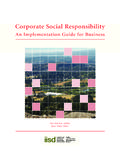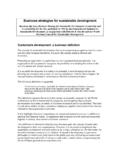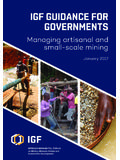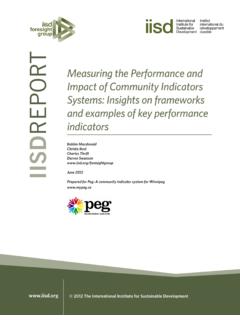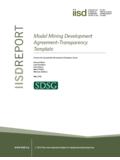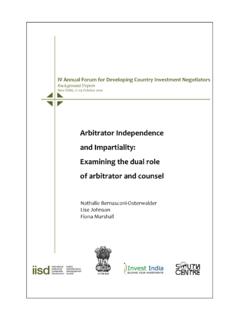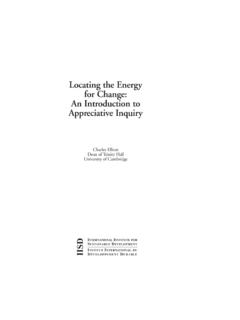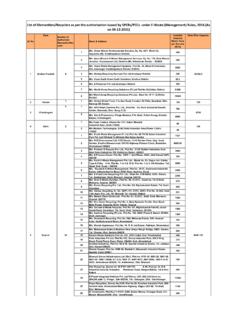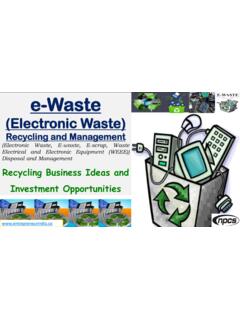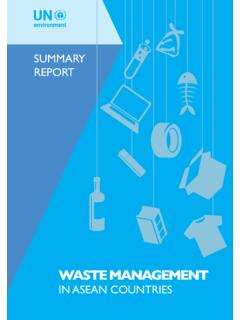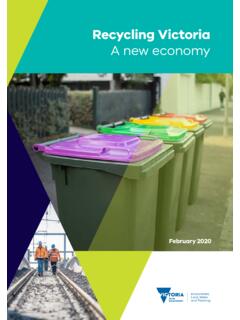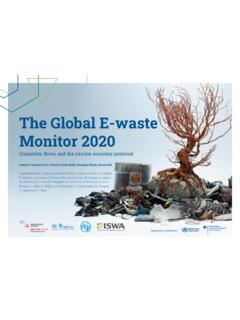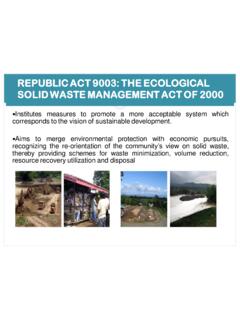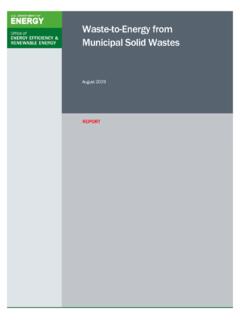Transcription of Sustainability: Second Life Cobalt Lithium Recycling
1 Clare Church Laurin Wuennenberg March 2019 2019 International Institute for Sustainable Development | and Second Life: The case for Cobalt and Lithium Recycling Sustainability and Second Life: The case for Cobalt and Lithium Recycling Clare Church Laurin Wuennenberg March ivSustainability and Second Life: The case for Cobalt and Lithium Recycling Head Office111 Lombard Avenue, Suite 325 Winnipeg, Manitoba Canada R3B 0T4 Te l : +1 (204) 958-7700 Website: Twitter: @IISD_news 2019 The International Institute for Sustainable Development Published by the International Institute for Sustainable Development. International Institute for Sustainable DevelopmentThe International Institute for Sustainable Development (IISD) is an independent think tank championing sustainable solutions to 21st century problems. Our mission is to promote human development and environmental sustainability.
2 We do this through research, analysis and knowledge products that support sound policymaking. Our big-picture view allows us to address the root causes of some of the greatest challenges facing our planet today: ecological destruction, social exclusion, unfair laws and economic rules, a changing climate. IISD s staff of over 120 people, plus over 50 associates and 100 consultants, come from across the globe and from many disciplines. Our work affects lives in nearly 100 countries. Part scientist, part strategist IISD delivers the knowledge to is registered as a charitable organization in Canada and has 501(c)(3) status in the United States. IISD receives core operating support from the Province of Manitoba and project funding from numerous governments inside and outside Canada, United Nations agencies, foundations, the private sector and individuals. Sustainability and Second Life: The case for Cobalt and Lithium Recycling March 2019 Written by Clare Church and Laurin Wuennenberg vAcknowledgementThe authors are grateful to the following peer reviewers for their invaluable feedback and suggestions through the process of drafting this document: Alec Crawford, Senior Researcher, International Institute for Sustainable Development Greg Radford, Director, IGF Michael Green, Consultant, Michael Green Consulting Jane Korinek, Economist, Trade Policy Analyst, OECD The authors would also like to thank Ajay Kochhar, Paul Jennings, Joakim Krook, Michael Green and Larry Reaugh for their invaluable contributions throughout the stakeholder interviews.
3 The opinions expressed and arguments employed in this report do not necessarily reflect those of the funders, interviewees or peer reviewers, nor should they be attributed to them. viSustainability and Second Life: The case for Cobalt and Lithium Recycling Executive SummaryTo support the transition to a low-carbon economy, governments, businesses and consumers around the world are investing considerable amounts in renewable energy technologies , including electric vehicles (EVs), solar panels and wind turbines. Cobalt and Lithium are central to the development and deployments of these technologies largely due to their use in Lithium -ion batteries and as such, the demand for both minerals has and is predicted to increase substantially. The supplies of both minerals, however, is not projected to meet the demand, with shortfalls expected in the coming decade.
4 Concerns along the supply chains of both minerals including the potential use of child labour in Cobalt extraction and the intensive use of water and energy in Lithium production place additional strain on the responsible sourcing of both. The circular economy entails gradually decoupling economic activity from the consumption of finite resources, and designing [permanent] waste out of the system. Cobalt and Lithium Recycling , as part of the circular economy, offers a solution to overcome these supply chain issues by extracting metals and minerals from products and infrastructure no longer in use. Moreover, increased mineral Recycling could contribute to the commitments set out by the Paris Agreement and the 2030 Agenda for Sustainable Development. Despite these advantages, current Recycling rates for Cobalt are relatively low, while those for Lithium are historically insignificant.
5 Through desk-based research, case study analysis and consultations with mineral Recycling stakeholders and businesses, this report explores the potential of Cobalt and Lithium Recycling . It examines existing and perceived barriers to mineral Recycling , answering why current Recycling rates for Cobalt and Lithium are so low. It follows by identifying opportunities and solutions along the supply chains of both minerals to increase Recycling . This is justified within the context of the circular economy and the Sustainable Development Goals (SDGs). viiKey Findings Increased mineral Recycling could fulfill some of the goals of the circular economy by reducing reliance on finite resources and mitigating permanent waste disposal. It could also directly contribute to SDGs 7, 8, 9, 12, 13, and 16, among others. Many of the barriers that exist to Cobalt and Lithium Recycling originate in the primary supply chain.
6 These challenges may include conflict or corruption at extraction sites, raw material price fluctuations, design of the product without consideration of Second -life uses and the hibernation of electronics. Inefficient collection infrastructure, technological and safety concerns, and transparency issues regarding secondary processes may also act as barriers to the increased Recycling of Cobalt and Lithium . Moreover, the stockpiles of end-of-life products containing Cobalt and Lithium may not be large or homogenous enough to mandate investments in more efficient collection infrastructure and Recycling technologies . Lithium -ion battery Recycling processes on the market today do not recover the Lithium , and instead tend to retrieve only the Cobalt or nickel therein. Many actors do not deem Lithium recovery economically viable. Increased collaboration is required between the public sector, private actors and civil society to overcome market and regulatory barriers.
7 This coordination is essential to ensure that new or revised investments and regulations are reflective of the changing needs of the Recycling industry. In particular, efforts should be made by the public sector to develop and understand applicable definitions of Recycling and other secondary processes, clearly designate the actors responsible and liable for Recycling materials, communicate these regulations to businesses and consumers, and evaluate the risks and benefits of mineral Recycling using multiple values. Recycling has long been a central tenet of circular business models and sustainable development. But its adoption in the mining sector has not been widespread or comprehensive. It is paramount that Recycling be incorporated into metal and mineral supply chains and especially those of Cobalt and Lithium in order to ensure a responsible, sustainable and stable transition to a low-carbon economy.
8 ViiiSustainability and Second Life: The case for Cobalt and Lithium Recycling Table of Introduction .. The Context for Lithium and Cobalt Recycling .. Background and Terminology .. Motivations for Mineral Recycling .. Significance to the Circular Economy .. Significance to the Sustainable Development Goals .. Existing and Perceived Barriers to Mineral Recycling .. Barriers Along the Primary Supply Chain .. Barriers Along the Recycling Supply Chain .. Cross-Cutting Regulatory Barriers .. Opportunities and Recommendations .. Opportunities Along the Primary Supply Chain .. Opportunities Along the Recycling Supply Chain .. Cross-Cutting Regulatory Opportunities and Recommendations .. Conclusions ..39 References ..42 Annex 1: waste Disposal and Recycling Governance Mechanisms .. ixList of FiguresFigure 1. Integrating the Circular Economy into Cobalt & Lithium Supply Chains.
9 6 Figure 2. Barriers to Lithium and Cobalt Recycling along the supply chains ..17 Figure 3. Opportunities to address the barriers in the Lithium and Cobalt Recycling supply chains ..28 List of BoxesBox 1. Definitions of Key Terms ..8 Box 2. waste Disposal and Recycling Governance Mechanisms ..14 List of Case StudiesCase Study 1: Reusing End-Of-Life EV Batteries for Less-Demanding Applications ..32 Case Study 2: Urban and Landfill Mining in Study 3: Recovering the Lithium in Lithium -Ion Batteries ..35 Case Study 4: Incentivizing Lithium -Ion Battery Recycling Through Grants in the United States .. xSustainability and Second Life: The case for Cobalt and Lithium Recycling Acronyms and Abbreviations CCME Canadian Council of Ministers of the Environment DRC Democratic Republic of CongoEPR Extended Producer Responsibility EU European UnionEV electric vehicleE- waste electronic wasteOECD Organisation for Economic Co-operation and DevelopmentR&D research and developmentSAVi Sustainable Asset Valuation SDG Sustainable Development GoalUN United NationsWEEE waste of Electrical and Electronic Equipment IntroductionKey Messages: To support the transition to a low-carbon economy, governments, businesses and consumers around the world are investing considerable amounts in renewable energy technologies including wind turbines, solar panels, and electric vehicles.
10 Lithium and Cobalt are central to the development and deployment of renewable energy technologies . Estimates project, however, that both will experience supply shortages in the coming decades. Mineral Recycling , as part of the circular economy, has the potential to overcome these shortages and other supply chain challenges by extracting metals and minerals from products and infrastructure no longer in 2 Sustainability and Second Life: The case for Cobalt and Lithium Recycling Renewable energy technologies including wind turbines, solar panels, and electric vehicles (EVs) are a necessary part of a sustainable future. The UN s Sustainable Development Goals (SDGs), adopted by the UN General Assembly in 2015, stress the importance of these technologies ; Goal 7 calls for Affordable and Clean Energy, aiming to increase substantially the global share of renewable energy by 2030 (United Nations, 2018).
